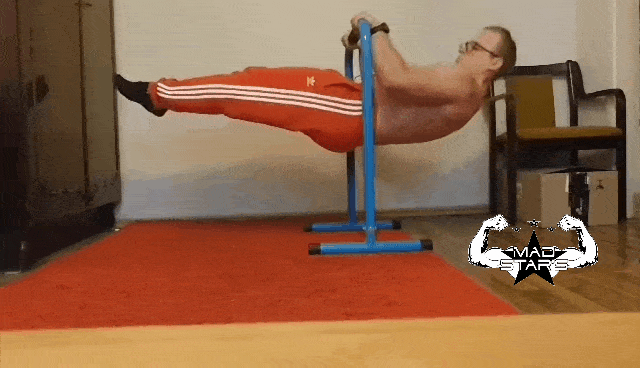Full Front Lever Pull-Up

Primary Muscle Group
Lats
Secondary Muscle Groups
Description
The Front Lever Pull-Up is an advanced bodyweight exercise that combines pulling strength with core control, requiring a high level of lat engagement, scapular control, and core stability. This movement is a progression from the front lever hold and is used to develop upper body pulling strength, gymnastics skills, and calisthenics control.
Unlike traditional pull-ups, where your body moves vertically, front lever pull-ups require you to remain in a horizontal position throughout the movement. This makes the exercise significantly more challenging, as it demands full-body tension, straight arm strength, and posterior chain coordination.
How to Perform Front Lever Pull-Ups
1. Prerequisites & Strength Requirements
Before attempting Front Lever Pull-Ups, you should be able to perform:
✅ 10-15 Strict Pull-Ups
✅ 5+ Chest-to-Bar Pull-Ups
✅ 5-10 L-Sit Pull-Ups
✅ Advanced Core Strength (Front Lever Hold for 5-10s)
✅ Scapular Control & Shoulder Stability
2. Starting Position:
- Hang from a bar or gymnastic rings with an overhand grip (pronated), hands about shoulder-width apart.
- Engage your core and scapula by pulling your shoulders down and back (scapular depression).
- Raise your body into a full front lever position by keeping your body horizontal and parallel to the ground, with a straight line from head to toes.
- Your arms should be fully extended, and your core, glutes, and legs should be tight.
3. Initiating the Pull-Up:
- Begin the pulling motion by engaging your lats and upper back while keeping your body in a straight line.
- Unlike a standard pull-up, your body should remain parallel to the ground as you move.
- Pull your chest toward the bar by bending your elbows while maintaining tight core tension.
4. Peak Contraction:
- At the top of the movement, your chest should be close to the bar, with your body still in a horizontal front lever position.
- Squeeze your lats and hold the top position briefly to maximize muscle activation.
- Keep your legs extended and glutes engaged to maintain core stability.
5. Lowering Phase:
- Slowly lower yourself back to the starting position in a controlled motion, maintaining the front lever hold.
- Avoid dropping down too quickly, as this can cause unnecessary strain on your shoulders and elbows.
- Maintain scapular engagement and core control throughout the descent.
6. Repetitions and Sets:
- Beginner: 3-5 reps x 3 sets
- Intermediate: 6-10 reps x 3-4 sets
- Advanced: 12+ reps x 4-5 sets
? Rest Time: 90-120 seconds between sets (or more if needed for recovery).
Progressions and Scaling Options
Easier Variations:
- Tuck Front Lever Pull-Ups – Perform the movement with your knees tucked toward your chest, reducing leverage and making the pull-up easier.
- Advanced Tuck Front Lever Pull-Ups – Keep your back rounded slightly and extend your legs slightly outward to increase difficulty.
- One-Leg Extended Front Lever Pull-Ups – Extend one leg straight while keeping the other leg tucked.
- Banded Front Lever Pull-Ups – Use a resistance band for support, attaching it to the bar and placing it around your lower back or feet to assist the movement.
Harder Variations:
- Weighted Front Lever Pull-Ups – Hold a dumbbell or wear a weighted vest to increase resistance.
- Slow Negative Front Lever Pull-Ups – Lower yourself extremely slowly (5-10 seconds per rep) to build eccentric strength.
- Archer Front Lever Pull-Ups – Pull up toward one side at a time, increasing unilateral control.
- One-Arm Front Lever Pull-Ups – The ultimate challenge, requiring extreme lat and core strength.
Tips for Maximum Effectiveness
✅ Maintain Full-Body Tension – Engage your glutes, core, and legs to maintain a straight-body position.
✅ Scapular Activation is Key – Before pulling, ensure your shoulders are depressed (not shrugged up) for lat activation.
✅ Control the Eccentric Phase – Lower yourself slowly to maximize muscle engagement and build strength.
✅ Avoid Arching Your Lower Back – Your body should stay in a straight line without excessive arching.
✅ Train Core & Lower Back Separately – Strengthen your lower back, glutes, and core to help maintain the lever position.
Common Mistakes to Avoid
❌ Breaking the Front Lever Position – Keep your body rigid and straight; do not bend at the hips or sag.
❌ Shrugging the Shoulders – Keep scapula depressed to prevent strain on the shoulders.
❌ Using Momentum – Avoid kipping or swinging; the movement should be strict and controlled.
❌ Neglecting Core Engagement – A weak core will make it impossible to maintain proper form.
If you’ve found these exercises helpful or if they’ve helped you reach your fitness goals, please consider supporting me. Your contribution helps me continue creating high-quality, free content for everyone. With your support, I can continue to grow, improve, and bring you more amazing resources.
